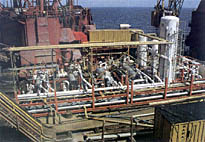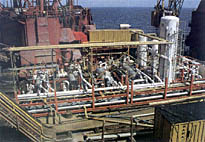
Yemen’s Oil and Gas Industry: No Breakthrough in Sight! [Archives:1999/02/Business & Economy]
January 11 1999
Oil Discovery in Yemen
Oil & gas exploration started officially in 1978 and in 1979 in northern and southern Yemen oil fields, respectively. The first oil discovery was announced in 1984 by Yemen Hunt Oil Company at its Marib/Al-Jawf concession.

Other companies were also feverishly looking for oil. The other most successful case is that of Canadian Occidental Petroleum Yemen, which made a strike at the Masila Block in Hadhramaut. Other discoveries were made by Nimr Petroleum and Total in East Shabwah as well as at the Jannah fields.
Yemen’s dream of becoming a large oil producer is gone, by now. Most experts agree that if any discovery is ever to be made, it is not going to make the country a large producer. Besides, the continued an dramatic fall in oil prices has taken away the incentive to plough in large investments in search for the crude.
The country produces today just less than 400,000 barrels per day, and the volume is expected to rapidly fall unless new discoveries and tertiary extracting make up for production loss. Since oil production started nearly 15 years ago, the country has exported over one billion barrels of oil.
Other Resources:
By the mid-1990s, the country’s associated gas out of the Marib/Al-Jawf fields have proven commercial. Recoverable reserves were put at around 15 trillion cubic feet, and efforts were launched for a rapid exploitation of this new wealth.
But political bickering, corruption and administrative inefficiency have not allowed an early take-off. By the time an agreement was ironed out – bringing together Total, Exxon, Hunt and others, world conditions have changed dramatically.
To start with, other producers in Australia, Southeast Asia, the Persian Gulf and Central Asia have already made a head-start. The potential markets in the Far East and south Asia plunged into economic problems thus affecting future demand. Financial constraints to meet investment requirements have also compounded the difficulties.
As a result, Yemen’s gas project is practically dead. But that may just be good for the country. Besides the problems associated with mis-management of the revenues that could have flown in, the gas could come handy in generating future electricity needs.
There were also other discoveries of minerals in commercial quantities. These include copper, zinc, uranium, radium, and gold. But exploitation requires large investments which are not available due to the local investment climate.
New Offers, but No Take-Off!
The Yemeni government organized an international conference in September 1998 to focus on the potential of Yemen’s oil & gas sector. A small number of businessmen attended, but there were no takers. The Yemeni government then threw in sweeteners by improving the terms and conditions of the production-sharing agreements. This time, there were takers, but no take off.
The condition of the oil and gas sector reflect the overall situation of the country. Political difficulties almost leading to an impasse in the relations of the authorities with the local population, administrative weaknesses, and above all, the greed and corruption of senior power centers have hampered the proper development of the sector.
By: Ghassan Al-Ahdal,
Yemen Times
——
[archive-e:02-v:1999-y:1999-d:1999-01-11-p:./1999/iss02/b&e.htm]


